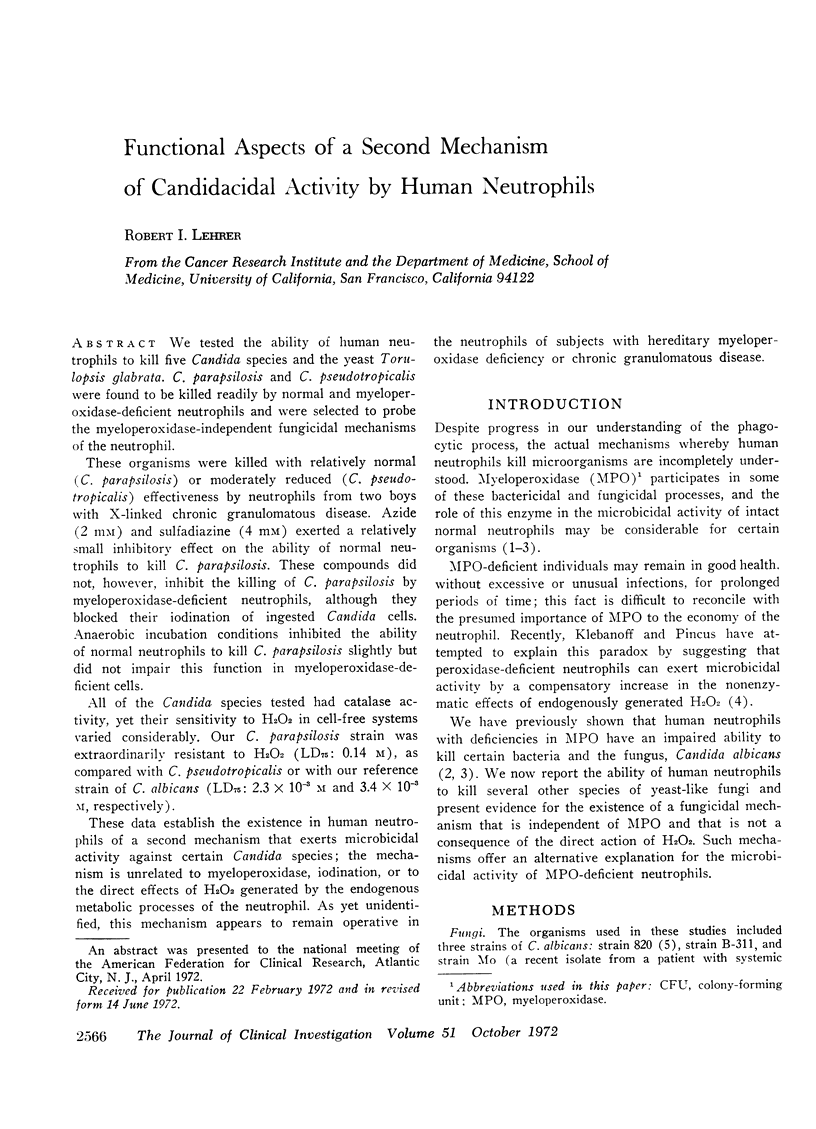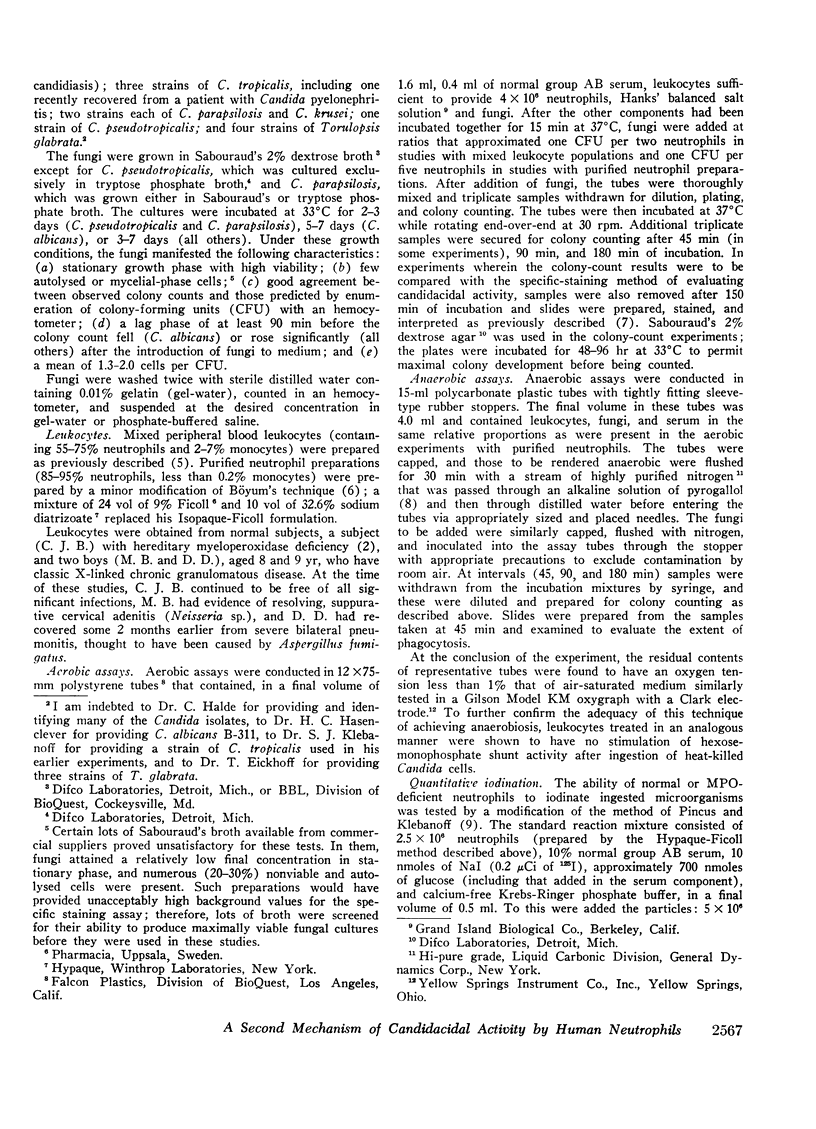Abstract
We tested the ability of human neutrophils to kill five Candida species and the yeast Torulopsis glabrata. C. parapsilosis and C. pseudotropicalis were found to be killed readily by normal and myeloperoxidase-deficient neutrophils and were selected to probe the myeloperoxidase-independent fungicidal mechanisms of the neutrophil.
These organisms were killed with relatively normal (C. parapsilosis) or moderately reduced (C. pseudotropicalis) effectiveness by neutrophils from two boys with X-linked chronic granulomatous disease. Azide (2 mm) and sulfadiazine (4 mm) exerted a relatively small inhibitory effect on the ability of normal neutrophils to kill C. parapsilosis. These compounds did not, however, inhibit the killing of C. parapsilosis by myeloperoxidase-deficient neutrophils, although they blocked their iodination of ingested Candida cells. Anaerobic incubation conditions inhibited the ability of normal neutrophils to kill C. parapsilosis slightly but did not impair this function in myeloperoxidase-deficient cells.
All of the Candida species tested had catalase activity, yet their sensitivity to H2O2 in cell-free systems varied considerably. Our C. parapsilosis strain was extraordinarily resistant to H2O2 (LD75: 0.14 m), as compared with C. pseudotropicalis or with our reference strain of C. albicans (LD75: 2.3 × 10−3m and 3.4 × 10−3m, respectively).
These data establish the existence in human neutrophils of a second mechanism that exerts microbicidal activity against certain Candida species; the mechanism is unrelated to myeloperoxidase, iodination, or to the direct effects of H2O2 generated by the endogenous metabolic processes of the neutrophil. As yet unidentified, this mechanism appears to remain operative in the neutrophils of subjects with hereditary myeloperoxidase deficiency or chronic granulomatous disease.
Full text
PDF






Selected References
These references are in PubMed. This may not be the complete list of references from this article.
- Böyum A. Isolation of mononuclear cells and granulocytes from human blood. Isolation of monuclear cells by one centrifugation, and of granulocytes by combining centrifugation and sedimentation at 1 g. Scand J Clin Lab Invest Suppl. 1968;97:77–89. [PubMed] [Google Scholar]
- Holmes B., Page A. R., Good R. A. Studies of the metabolic activity of leukocytes from patients with a genetic abnormality of phagocytic function. J Clin Invest. 1967 Sep;46(9):1422–1432. doi: 10.1172/JCI105634. [DOI] [PMC free article] [PubMed] [Google Scholar]
- Klebanoff S. J. Iodination of bacteria: a bactericidal mechanism. J Exp Med. 1967 Dec 1;126(6):1063–1078. doi: 10.1084/jem.126.6.1063. [DOI] [PMC free article] [PubMed] [Google Scholar]
- Klebanoff S. J. Myeloperoxidase: contribution to the microbicidal activity of intact leukocytes. Science. 1970 Sep 11;169(3950):1095–1097. doi: 10.1126/science.169.3950.1095. [DOI] [PubMed] [Google Scholar]
- Klebanoff S. J., Pincus S. H. Hydrogen peroxide utilization in myeloperoxidase-deficient leukocytes: a possible microbicidal control mechanism. J Clin Invest. 1971 Oct;50(10):2226–2229. doi: 10.1172/JCI106718. [DOI] [PMC free article] [PubMed] [Google Scholar]
- Lehrer R. I. Antifungal effects of peroxidase systems. J Bacteriol. 1969 Aug;99(2):361–365. doi: 10.1128/jb.99.2.361-365.1969. [DOI] [PMC free article] [PubMed] [Google Scholar]
- Lehrer R. I., Cline M. J. Interaction of Candida albicans with human leukocytes and serum. J Bacteriol. 1969 Jun;98(3):996–1004. doi: 10.1128/jb.98.3.996-1004.1969. [DOI] [PMC free article] [PubMed] [Google Scholar]
- Lehrer R. I., Cline M. J. Leukocyte myeloperoxidase deficiency and disseminated candidiasis: the role of myeloperoxidase in resistance to Candida infection. J Clin Invest. 1969 Aug;48(8):1478–1488. doi: 10.1172/JCI106114. [DOI] [PMC free article] [PubMed] [Google Scholar]
- Lehrer R. I. Inhibition by sulfonamides of the candidacidal activity of human neutrophils. J Clin Invest. 1971 Dec;50(12):2498–2505. doi: 10.1172/JCI106750. [DOI] [PMC free article] [PubMed] [Google Scholar]
- Lehrer R. I. Measurement of candidacidal activity of specific leukocyte types in mixed cell populations I. Normal, myeloperoxidase-deficient, and chronic granulomatous disease neutrophils. Infect Immun. 1970 Jul;2(1):42–47. doi: 10.1128/iai.2.1.42-47.1970. [DOI] [PMC free article] [PubMed] [Google Scholar]
- McCall C. E., DeChatelet L. R., Cooper M. R., Ashburn P. The effects of ascorbic acid on bactericidal mechanisms of neutrophils. J Infect Dis. 1971 Aug;124(2):194–198. doi: 10.1093/infdis/124.2.194. [DOI] [PubMed] [Google Scholar]
- Pincus S. H., Klebanoff S. J. Quantitative leukocyte iodination. N Engl J Med. 1971 Apr 8;284(14):744–750. doi: 10.1056/NEJM197104082841402. [DOI] [PubMed] [Google Scholar]


